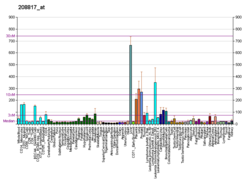Val158Met polymorphism
A functional single-nucleotide polymorphism (a common normal variant) of the gene for catechol-O-methyltransferase results in a valine to methionine mutation at position 158 (Val158Met) rs4680. [14] In vitro, the homozygous Val variant metabolizes dopamine at up to four times the rate of its methionine counterpart. [21] However, in vivo the Met variant is overexpressed in the brain, [27] resulting in a 40% decrease (rather than 75% decrease) in functional enzyme activity. [28] The lower rates of catabolism for the Met allele results in higher synaptic dopamine levels following neurotransmitter release, ultimately increasing dopaminergic stimulation of the postsynaptic neuron. Given the preferential role of COMT in prefrontal dopamine degradation, the Val158Met polymorphism is thought to exert its effects on cognition by modulating dopamine signaling in the frontal lobes.
The gene variant has been shown to affect cognitive tasks broadly related to executive function, such as set shifting, response inhibition, abstract thought, and the acquisition of rules or task structure. [29] [30] [31]
Comparable effects on similar cognitive tasks, the frontal lobes, and the neurotransmitter dopamine have also all been linked to schizophrenia. [32] [33] It has been proposed that an inherited variant of COMT is one of the genetic factors that may predispose someone to developing schizophrenia later in life. [34] A more recent study cast doubt on the proposed connection between this gene and any alleged causal effect of cannabis on schizophrenia development. [35]
A non-synonymous single-nucleotide polymorphism rs4680 was found to be associated with depressed factor of Positive and Negative Syndrome Scale(PANSS) and efficiency of emotion in schizophrenia subjects. [36] It is increasingly recognised that allelic variation at the COMT gene are also relevant for emotional processing, as they seem to influence the interaction between prefrontal and limbic regions. Research conducted at the Section of Neurobiology of Psychosis, Institute of Psychiatry, King's College London has demonstrated an effect of COMT both in patients with bipolar disorder and in their relatives, [37] but these findings have not been replicated so far.
The COMT Val158Met polymorphism also has a pleiotropic effect on emotional processing. [37] [38] Furthermore, the polymorphism has been shown to affect ratings of subjective well-being. When 621 women were measured with experience sample monitoring, which is similar to mood assessment as response to beeping watch, the met/met form confers double the subjective mental sensation of well-being from a wide variety of daily events. The ability to experience reward increased with the number of Met alleles. [39] Also, the effect of different genotype was greater for events that were felt as more pleasant. The effect size of genotypic moderation was quite large: Subjects with the Val/Val genotype generated almost similar amounts of subjective well-being from a 'very pleasant event' as Met/Met subjects did from a 'bit pleasant event'. Genetic variation with functional impact on cortical dopamine tone has a strong influence on reward experience in the flow of daily life. [39] In one study participants with the met/met phenotype described an increase of positive affect twice as high in amplitude as participants with the Val/Val phenotype following very pleasant or pleasant events. [39]
One review found that those with Val/Val tended to be more extroverted, more novelty-seeking, and less neurotic than those with the Met/Met allele [40]









